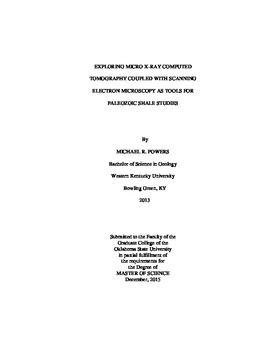| dc.description.abstract | Despite the ubiquity of shale in the rock record, the complex physical, biological, and chemical processes that determine its properties has inhibited our understanding of its origin and reservoir characteristics. The fine-grained texture and heterogeneity of shale, moreover, makes analysis challenging. Accordingly, the study of shale requires a systematic, multidisciplinary approach. Although scanning electron microscopy/energy dispersive spectroscopy (SEM/EDS) and x-ray computed tomography (CT) have been recognized as useful instruments for observing shale fabric on microscopic to nanoscopic scales, these tools remain underutilized. CT provides a noninvasive way to image specimens in three dimensions, and this thesis explores its utility for shale analysis. Shale samples from several Paleozoic formations in the southeastern and south-central United States were analyzed during this study. Qualitatively, CT facilitated the characterization of heterogeneity and a variety of depositional, diagenetic, and structural features. Features that were imaged include micro-scale rock fabric, physical and biogenic sedimentary structures, body fossils, diagenetic minerals, fractures, and faults. Quantitatively, data from CT were used to calculate volumetric percentages of porosity and mineral constituents. SEM/EDS data were collected from the samples used for CT analysis. The CT was used for pinpointing locations in which the microfabric could be further resolved and analyzed using SEM. SEM was then used observe pores, sulfide morphology, fossils, mineral grains, and fracture-filling cement. EDS allowed for rapid and straightforward determination of mineral composition. In turn, data gathered from SEM/EDS were used to supplement interpretations made from the CT analysis. This work demonstrates the utility of incorporating CT and SEM/EDS analyses into geologic workflows for the evaluation of shale. By using these technologies, microstructure can be related to macrostructure, thereby informing a range of sedimentologic, structural, and petrologic interpretations. | |
